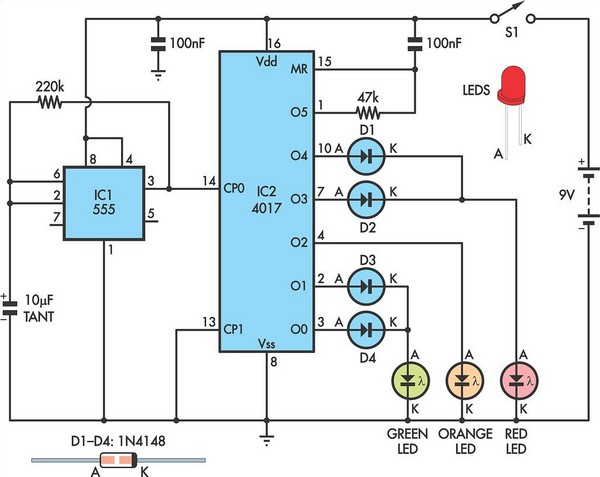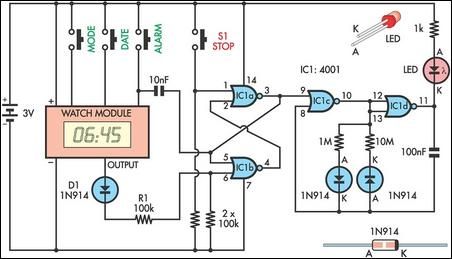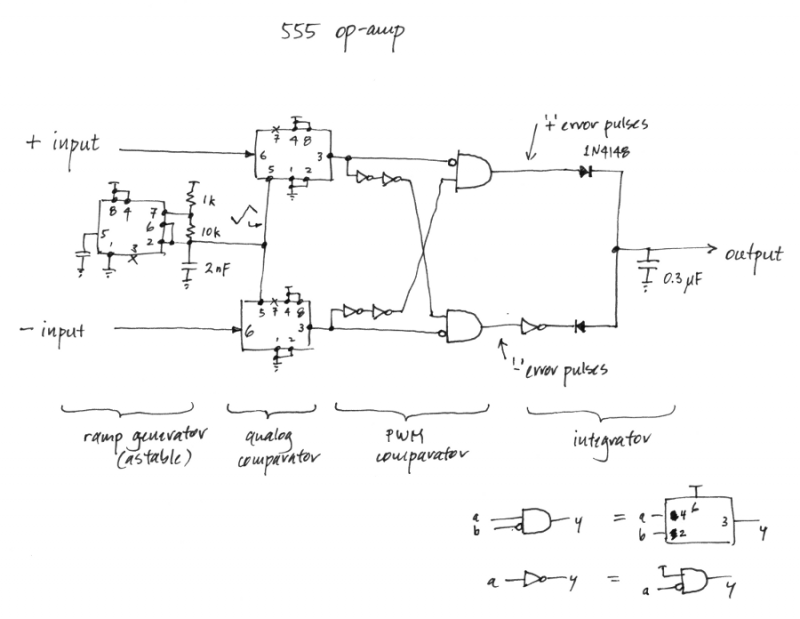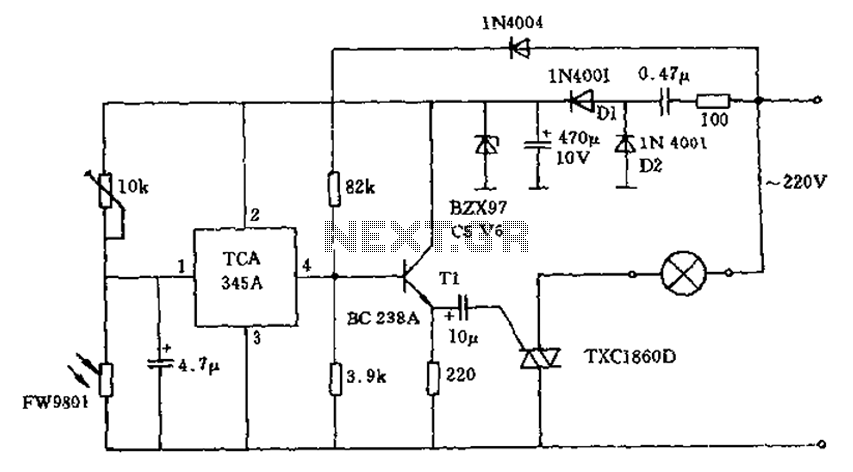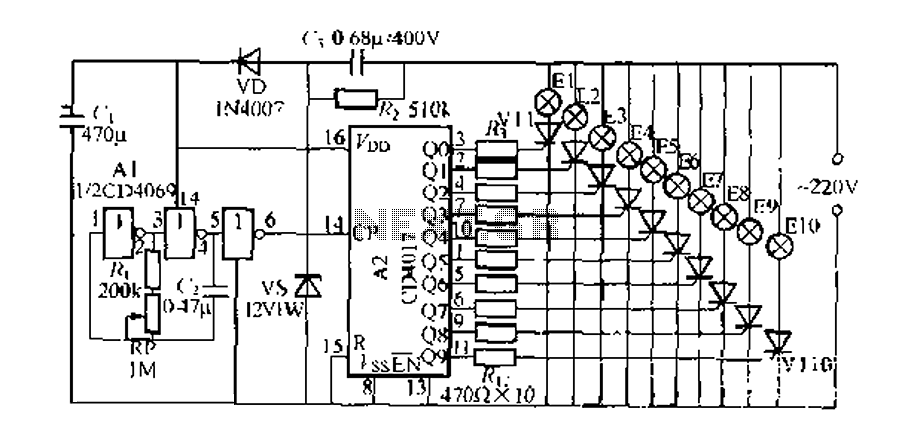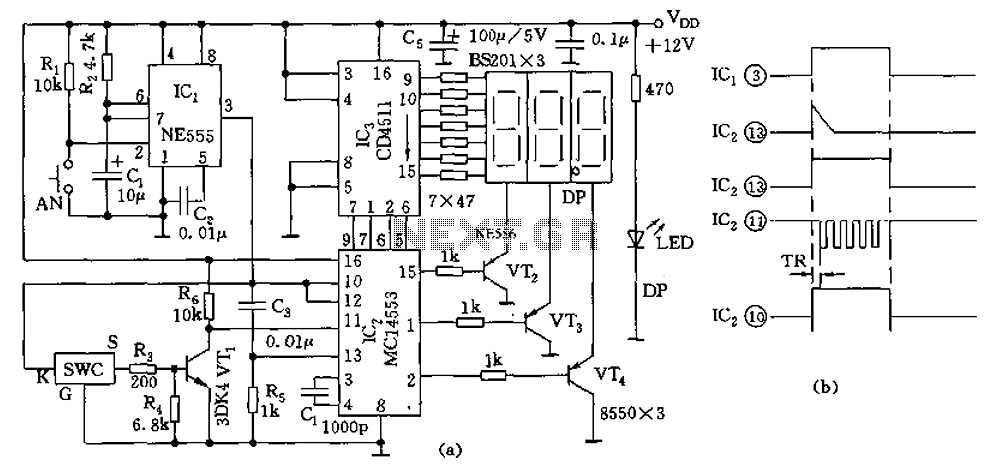
555 lights remind
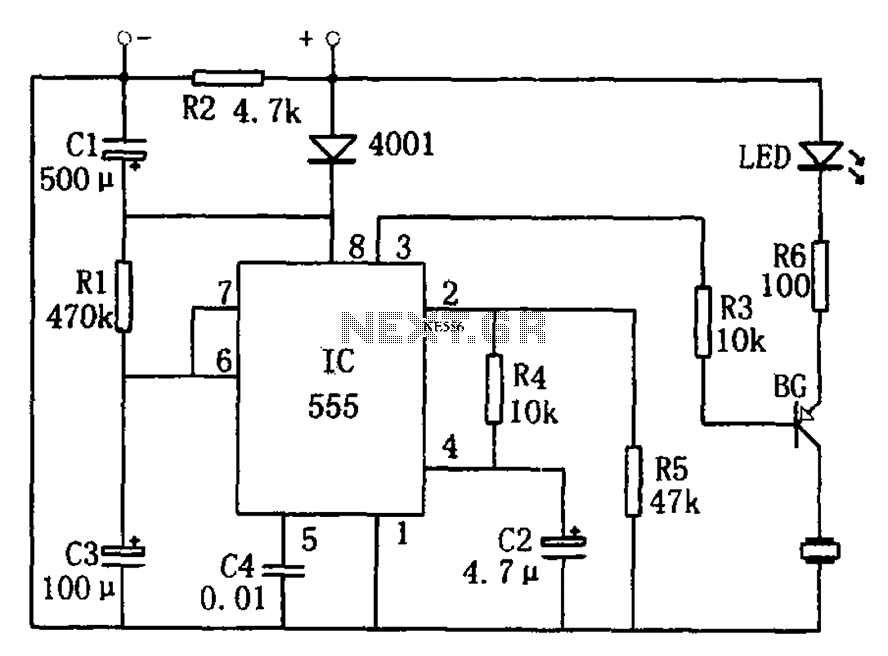
The circuit is designed to provide a reminder for lights using a monostable delay configuration. It comprises a monostable delay circuit, a driving circuit, a buzzer, light-emitting diodes (LEDs), and other components. The output signal from the delay circuit, which is based on the 555 timer IC, is controlled by resistor R1 and capacitor C3. The lights are powered through a relay circuit, with a diode connected to the 555 timer to facilitate signal processing. As the capacitor C3 charges through resistor R1, the potential at the timer's threshold pin rises. When this potential reaches approximately 2/3 of the supply voltage (VDD), a rollover occurs in the 555 timer, which switches the output low, enabling the buzzer and illuminating the LEDs. This serves as an alert for drivers to turn off their lights. The duration of the light and sound reminder corresponds to the delay time, which can be adjusted by modifying the time constant of the resistor-capacitor pair (R1 and C3). This circuit is particularly useful for reminding drivers to turn off their lights when they forget.
The circuit operates on the principle of a monostable multivibrator, utilizing a 555 timer IC, which is a versatile component in electronic circuits. In this configuration, the 555 timer is set up to generate a single output pulse when triggered. The timing interval is determined by the values of R1 (the resistor) and C3 (the capacitor), which form the RC time constant.
When power is applied, the circuit remains in a stable state until it is triggered by a momentary action, such as closing a switch. The trigger input of the 555 timer is connected to the relay, which is activated when the lights are turned on. This action causes the capacitor C3 to begin charging through R1. The charging process is exponential, and the voltage across C3 increases until it reaches the threshold level of approximately 2/3 VDD.
Upon reaching this threshold, the 555 timer switches its output state from high to low. This transition activates the output pin connected to the buzzer and the LED circuit. The buzzer emits a sound, and the LEDs light up, providing a visual and auditory reminder to the driver. The duration of this alert signal corresponds to the time it takes for C3 to discharge through R1 once the trigger is removed, effectively providing a reminder for a predetermined time.
To adjust the delay time, one can modify the resistance value of R1 or the capacitance value of C3. Increasing either component will lengthen the delay, while decreasing them will shorten it. This flexibility allows for customization based on specific requirements or preferences.
In summary, this circuit is a practical solution for alerting drivers to turn off their lights, utilizing a simple yet effective monostable delay configuration that combines visual and auditory signals to enhance safety and prevent battery drain. As shown for the lights to remind the circuit. The circuit consists of monostable delay circuit, driving circuit, buzzer, light-emitting diodes and other components. Wherein th e one-shot output signal from the delay circuit 555 and R1, C3 composed of control behind the circuit.After the lights from the direction of the lamp power supply circuit in the relay through the diode is added to 555 feet, so that the capacitor C3 is charged via R1. As the charging progresses, foot potential rise when foot potential reaches 2/3VDD (approximately l minute delay) after 555 rollover occurs, low output enable pin BG conduction.
Corresponding drive LED light, buzzer, the sound and light signals to alert drivers timely lights.Circuit in the lights corresponding to the length of time that is the delay time of the circuit can be changed by adjusting the time constant R1C3. When this circuit is implemented in the direction of the driver forgot to turn off lights, turn off the power in time to remind drivers.
The circuit operates on the principle of a monostable multivibrator, utilizing a 555 timer IC, which is a versatile component in electronic circuits. In this configuration, the 555 timer is set up to generate a single output pulse when triggered. The timing interval is determined by the values of R1 (the resistor) and C3 (the capacitor), which form the RC time constant.
When power is applied, the circuit remains in a stable state until it is triggered by a momentary action, such as closing a switch. The trigger input of the 555 timer is connected to the relay, which is activated when the lights are turned on. This action causes the capacitor C3 to begin charging through R1. The charging process is exponential, and the voltage across C3 increases until it reaches the threshold level of approximately 2/3 VDD.
Upon reaching this threshold, the 555 timer switches its output state from high to low. This transition activates the output pin connected to the buzzer and the LED circuit. The buzzer emits a sound, and the LEDs light up, providing a visual and auditory reminder to the driver. The duration of this alert signal corresponds to the time it takes for C3 to discharge through R1 once the trigger is removed, effectively providing a reminder for a predetermined time.
To adjust the delay time, one can modify the resistance value of R1 or the capacitance value of C3. Increasing either component will lengthen the delay, while decreasing them will shorten it. This flexibility allows for customization based on specific requirements or preferences.
In summary, this circuit is a practical solution for alerting drivers to turn off their lights, utilizing a simple yet effective monostable delay configuration that combines visual and auditory signals to enhance safety and prevent battery drain. As shown for the lights to remind the circuit. The circuit consists of monostable delay circuit, driving circuit, buzzer, light-emitting diodes and other components. Wherein th e one-shot output signal from the delay circuit 555 and R1, C3 composed of control behind the circuit.After the lights from the direction of the lamp power supply circuit in the relay through the diode is added to 555 feet, so that the capacitor C3 is charged via R1. As the charging progresses, foot potential rise when foot potential reaches 2/3VDD (approximately l minute delay) after 555 rollover occurs, low output enable pin BG conduction.
Corresponding drive LED light, buzzer, the sound and light signals to alert drivers timely lights.Circuit in the lights corresponding to the length of time that is the delay time of the circuit can be changed by adjusting the time constant R1C3. When this circuit is implemented in the direction of the driver forgot to turn off lights, turn off the power in time to remind drivers.
